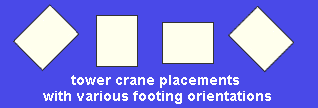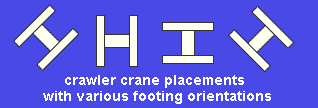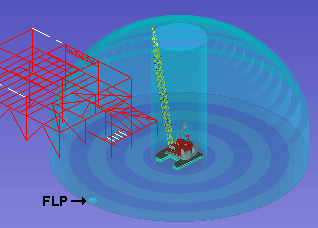 Add Crane Placement ( Modeling )
Add Crane Placement ( Modeling )
Tool summary :
- See the step-by-step instructions .
Also see :
|
- Crane Placement (window that Add Crane Placement opens)
- Cranes and crane placements (topic)
page 1 | contents | model > crane > | cranes | cranes (index) | crane placement window | top
 Add Crane Placement (step-by-step instructions)
Add Crane Placement (step-by-step instructions)
You should be in a plan view in Modeling at the elevation you want to add the crane placement to. The crane to which you want to associate with the crane placement should be selectable in that view. When you add a crane placement, it is required (in step 2 ) that you select the crane that the placement is to be used for.
1 . Invoke Add Crane Placement using any one (1) of the following methods:
Method 1 : Click the Add Crane Placement icon. The icon can be taken from the group named ' Model -- Cranes ' and placed on a toolbar (classic) or the ribbon (lightning).
Method 2 : If " Modeling layout style " is ' Classic ', you can use the menu system to choose Model > Cranes > Add Crane Placement .
Method 3, 4 or 5 : Add Crane Placement can also be configured to be invoked using a keyboard shortcut , the context menu , or a mode . For the lightning interface, this configuration is done using Customize Interface .
2 . The status line prompts, " Locate crane ." Select One Item mouse bindings become active.
|
|
|
Select One Item bindings |
2a : Move your mouse pointer (
) so that it hovers the crane that you want to add this crane placement for. If User and Site Options > Modeling > " Show balloon description " is turned on, the program will identify the crane's " Name ." Left-click ( Select ) to select the crane.
3 . The Crane Placement window opens.
3a : Enter a " Placement name " and choose a " Placement location " method. You may also want to set the " Lift Config " at this time. Press " OK " to continue.
4 (if applicable) : Skip this step if you selected " Enter location " in the previous step. If you selected " Select location " or " Select location with located elevation ," you will be prompted (by the status line ), to " Locate crane placement ."
|
|
|
mouse bindings |
4a : Optionally select a Locate option (e.g., INCL ), then move your mouse pointer (
) so that the point location target (
) snaps to the point where you want the crane placement to be centered, then left-click ( Locate ).
Tip: The X, Y, Z display tells you the coordinates of a point.
5 . You will be prompted (by the status line ), to " Choose footing orientation ."
|
|
|
mouse bindings |

|
For a tower crane or a crawler crane, the footing orientation of the placement will not affect Lift Information for any lifts that you later assign to the placement -- it affects only the physical appearance of the placement in the model. This, however, is not true of a truck crane. |

|

|
For a truck crane, the footing orientation can affect Lift Information . A diagram like this one shows quadrants wherein the crane uses a different load chart to evaluate lifts. Lift Information for a lift in the green quadrant is calculated using a different load chart than the load chart that would be used for the same lift in the blue quadrant. |
5a : Move your mouse pointer (
) so that the point location target (
) snaps to any point along an axis that you want the crane placement to be oriented with respect to, then left-click ( Locate ).
6 . You will be prompted (by the status line ), to " Locate furthest laydown point ." The furthest laydown point is used as the pick point when Show Liftable Members evaluates liftability at the pick point. It is the default pick point " Location " for any member lift or load lift (user-defined lift) or multi-lift that you later assign to this placement.
|
|
|
mouse bindings |

|
When a crane placement is selected, the furthest laydown point for that placement is identified with a |
6a : Move your mouse pointer (
) so that the point location target (
) snaps to the point you want, then left-click ( Locate ).
7 . The crane placement is now at the location located in step 4 or at the location you specified in step 4 or step 3 (it you chose " Enter location " in step 3). The crane that you selected in step 2 moves to the newly added placement.
Tip: It you want to move the crane back to its original position, do an Edit Crane , then check the box for "
Change placement " on the window that opens (the Tower Crane or Crawler Crane window).
page 1 | contents | model > crane > | cranes | cranes (index) | crane placement window | top







